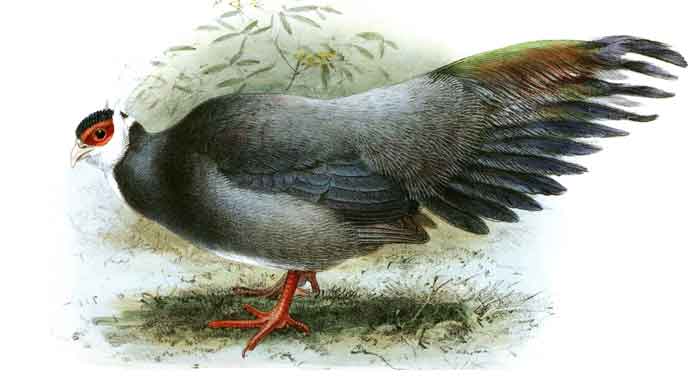
Crossoptilon harmani
Superregnum: Eukaryota
Cladus: Unikonta
Cladus: Opisthokonta
Cladus: Holozoa
Regnum: Animalia
Subregnum: Eumetazoa
Cladus: Bilateria
Cladus: Nephrozoa
Superphylum: Deuterostomia
Phylum: Chordata
Subphylum: Vertebrata
Infraphylum: Gnathostomata
Megaclassis: Osteichthyes
Cladus: Sarcopterygii
Cladus: Rhipidistia
Cladus: Tetrapodomorpha
Cladus: Eotetrapodiformes
Cladus: Elpistostegalia
Superclassis: Tetrapoda
Cladus: Reptiliomorpha
Cladus: Amniota
Classis: Reptilia
Cladus: Eureptilia
Cladus: Romeriida
Subclassis: Diapsida
Cladus: Sauria
Infraclassis: Archosauromorpha
Cladus: Crurotarsi
Divisio: Archosauria
Cladus: Avemetatarsalia
Cladus: Ornithodira
Subtaxon: Dinosauromorpha
Cladus: Dinosauriformes
Cladus: Dracohors
Cladus: Dinosauria
Cladus: Saurischia
Cladus: Eusaurischia
Subordo: Theropoda
Cladus: Neotheropoda
Cladus: Averostra
Cladus: Tetanurae
Cladus: Avetheropoda
Cladus: Coelurosauria
Cladus: Tyrannoraptora
Cladus: Maniraptoromorpha
Cladus: Maniraptoriformes
Cladus: Maniraptora
Cladus: Pennaraptora
Cladus: Paraves
Cladus: Eumaniraptora
Cladus: Avialae
Infraclassis: Aves
Cladus: Avebrevicauda
Cladus: Pygostylia
Cladus: Ornithothoraces
Cladus: Ornithuromorpha
Cladus: Carinatae
Parvclassis: Neornithes
Cohors: Neognathae
Cladus: Pangalloanserae
Cladus: Galloanseres
Ordo: Galliformes
Familia: Phasianidae
Subfamilia: Phasianinae
Genus: Crossoptilon
Species: Crossoptilon harmani
Name
Crossoptilon harmani Elwes, 1881
References
Ibis p. 399 pl.13
Vernacular names
čeština: Bažant pradéšský
English: Tibetan Eared Pheasant
español: Faisán orejudo tibetano
italiano: Fagiano orecchiuto del Tibet
lietuvių: Tibetinis ausuotasis fazanas
português: Faisão-orelhudo-tibetano
русский: Тибетский ушастый фазан
中文: 藏马鸡
The Tibetan eared pheasant (Crossoptilon harmani), also called Elwes' eared pheasant, is a species of bird in the family Phasianidae found in southeast Tibet and adjacent northern India, usually between 3,000 and 5,000 m (9,800 and 16,400 ft) elevation, but has been seen down to 2,280 m (7,500 ft) in winter. The species is named after Henry John Harman.
Their natural habitats are boreal and temperate forests. Seen in bushy and grassy clearings, rhododendron thickets, and tall dense scrub in valleys, these birds are threatened by habitat destruction and hunting. They form monogamous pair bonds in the spring. Their eggs are laid from May to July, and incubated by the females.
Description
The Tibetan eared pheasant shares many characteristics, such as the short ears and the droopy tail, with the white eared pheasant (C. crossoptilon), as well as having similar calls and hybridising with it in the Salween Valley, so the two may be conspecific. The Tibetan eared pheasant grows to a length between 75 and 85 cm (30 and 33 in), with females being slightly smaller than males. The sexes are similar. The beak is reddish-brown, the irises yellowish-orange, and the bare facial skin is red, as are the legs. The head is topped with a crown of black, dense, short feathers, on either side of which are short, nonprojecting ear tufts. The rest of the head and nape and a thin collar are white. The rest of the body, wings, and tail are bluish-grey, the mantle, neck and breast being of a darker shade, whereas the lower back, rump, upper tail coverts, and belly are paler whitish-grey. The wings are blackish-brown and the tail bluish-black.[3]
Distribution and habitat
Their range is restricted to Tibet, northern India, and northern Bhutan. Their typical habitat is dense scrubby areas in river valleys, grassy hillsides, and the verges of both coniferous and deciduous woodlands. Although sometimes found at elevations as low as 2,400 m (7,900 ft), they usually occur between about 3,000 and 5,000 m (9,800 and 16,400 ft).[1]
Ecology
These pheasants usually form groups of up to 10 individuals. They feed on the ground, foraging through the plant debris and grasses near woodland edges and among the rhododendron and juniper scrub. In areas where they are hunted, they may be elusive, retreating into the undergrowth or flying off downhill when scared, but where unmolested, can be quite bold. The birds are believed to be monogamous, with breeding taking place between May and July. One nest was discovered under a fallen tree trunk; it was made from bark and pulp with a mossy lining. The female seems to be solely responsible for incubating the eggs,[1] but both sexes have been observed feeding the chicks.[3]
Status
C. harmani is rated by the International Union for Conservation of Nature as being a "near-threatened species" because its natural habitat is being cleared, and in many areas, the birds are hunted. Another factor in the possible decline of the population is a reduction in the number of suitable places for roosting.[1]
References
BirdLife International (2016). "Crossoptilon harmani". IUCN Red List of Threatened Species. 2016: e.T22679287A95209471. doi:10.2305/IUCN.UK.2016-3.RLTS.T22679287A95209471.en. Retrieved 11 November 2021.
Elwes, H. J. (1881). "On a new Crossoptilon". Ibis. 4: 399–401.
McGowan, Phil; Madge, Steve (2010). Pheasants, Partridges & Grouse: Including buttonquails, sandgrouse and allies. Bloomsbury Publishing. pp. 313–314. ISBN 978-1-4081-3566-2.
Retrieved from "http://en.wikipedia.org/"
All text is available under the terms of the GNU Free Documentation License

